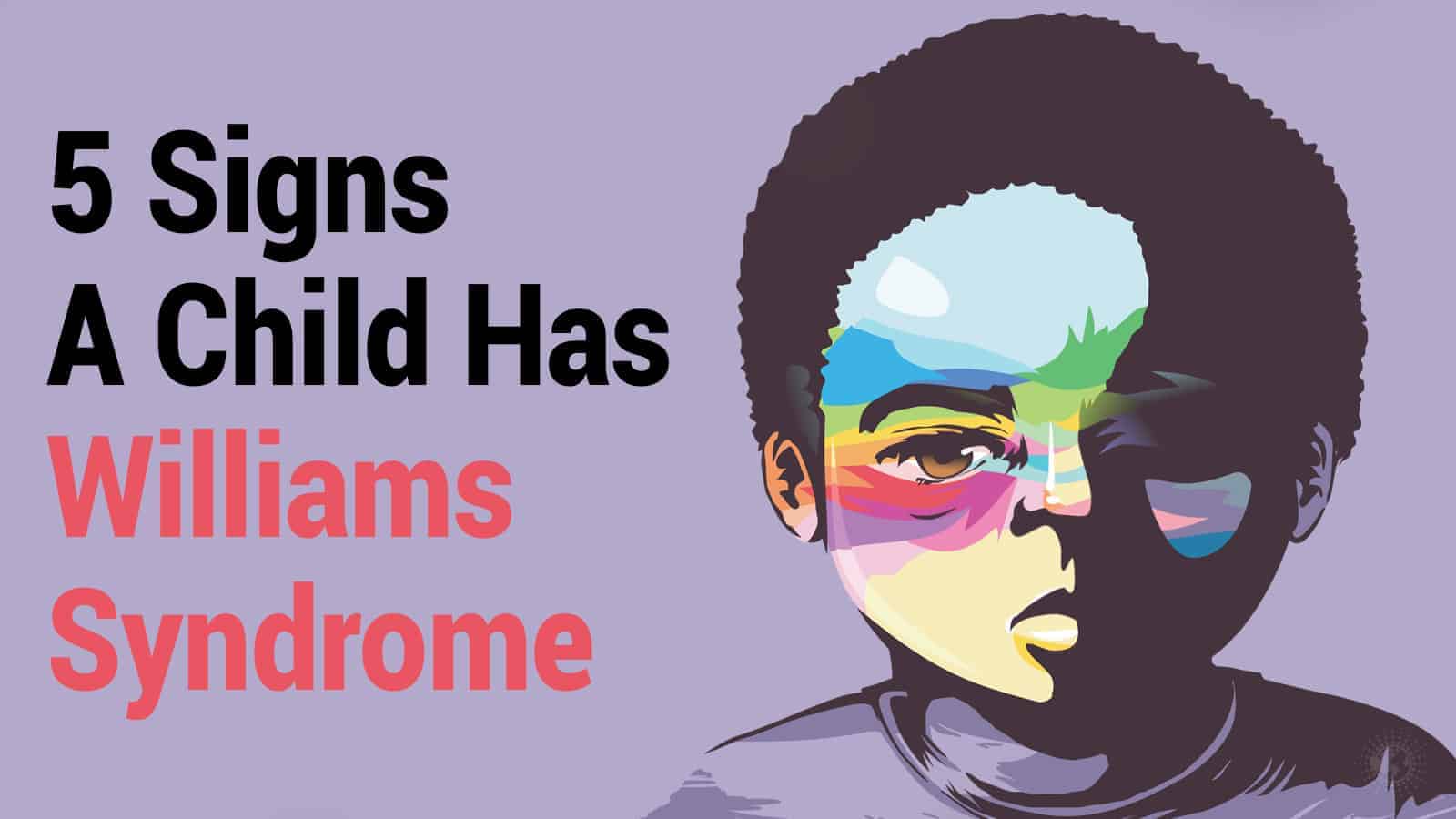Williams Syndrome is a rare condition seen in about one out of 20,000 kids born each year. It’s a developmental disorder that has no cure, but treatments and other therapy types can help. Sadly, the lifespan of a person suffering from this condition can live into their 60s, though it’s thought that this disease will shorten their years from 10-20 percent.
It was first discovered in 1961 by Dr. J.C.P. Williams, a physician in New Zealand, though knowledge of this condition has increased since then. Genetics plays a significant part in this disease, as it’s believed that someone who has this syndrome has a 50 percent chance of passing it along to their offspring.
Since there is no way to prevent this illness, someone diagnosed should seek medical advice before having a child.
What Causes Williams Syndrome?
This disorder is caused by an abnormality in the #7 chromosome, which helps with behavioral skills and cognitive abilities. There are 1,150 genes and over 940 pseudogenes in this chromosome. It’s by far the largest of all human DNA chips in the body.
There are 26 missing chromosomes in this gene. While that doesn’t sound like a great deal with so many, even one can cause abnormalities. One of the genes that are responsible for creating the protein known as Elastin is within this sector. It’s called the ELN.
ELN helps with neurodevelopment, and when this gene is missing, it can cause problems with the connective tissues. It’s also quite common for those missing ELN to have cardiovascular issues. Some of the other genes missing help with vision and processing what the eyes view.Sadly, a significant portion of these genes is responsible for cognitive and behavioral skills, which substantially impacts the person with this disease. While genetics are essential in this condition, no genetic factors may be involved.
Symptoms of Williams Syndrome
The list of symptoms that accompany this disease is extensive. Parents often notice children not hitting their milestones right away as a developmental disorder, while others may not notice immediately. Here are the most common issues with this syndrome:
In Children
- Attention Deficit Hyperactivity Disorder (ADHD)
- Acid reflux or chronic colic
- Problems with feeding and vomiting
- Delayed developmental milestones
- Learning disorders like dyslexia
- Mild to moderate cognitive delays
- Smaller than average stature
- Clinodactyly or small finger that bends inward
- Overly friendly and too trusting of strangers
- Fear of loud noises
- The unusual appearance of the face
- Pectus excavatum aka a sunken chest space
- Small nose with a flattened bridge that is upturned in appearance
- Larger lips and mouth always open slightly
- Small, widely-spaced teeth
- Defective tooth enamel
- A flap of skin covers the corners of the eyes.
- Obsession with music
- From the upper lip to the nose, there may be ridges of skin.
- Too skinny and problems gaining weight
- Prefers left side including eye and hand use
- Early hypothyroidism
- Hormonal abnormalities
- Farsightedness
- The iris inside the eye has an unusual problem.
- Hearing loss
In Adulthood
- Pulmonary Stenosis (the narrowing of the blood vessels)
- Supravalvular and pulmonary artery stenosis
- Seizures
- Rigid muscles
- Higher than average blood calcium levels
- High blood pressure
- Debilitating joint stiffness
- Anxiety and other mental health disorders
- Type II Diabetes
- Gastrointestinal issues
- Hearing loss
Making a Diagnosis
The first indication of Williams syndrome is usually peaked by physical symptoms and the unique look that this disease causes. A genetic test is a deciding factor when a doctor has a hunch that a child may have this disorder. The facial deformities usually include puffiness around the eyes, an abnormally large area between the top lip and the nose, and an unusual iris pattern.
Frequently, it’s the cardiac issues that are discovered in infancy. Babies present with heart murmurs as well as stenosis. The intense feeding disturbances of an infant is also concerning. As the child begins to age, the developmental delays become more apparent.
5 Signs Williams Syndrome is Present
Though there are many signs and symptoms, the five signs that primarily lead a doctor to suspect this ailment are these:
- Facial abnormalities
- A child not reaching their milestones
- Too skinny and problems gaining weight
- Feeding problems
- Infant cardiac issues
How Doctors Diagnose Williams Syndrome Conclusively
• DNA Testing
When Williams syndrome is suspected, two varieties of genetic tests are used, they are:
• Micro-Array Analysis
A microarray is called a DNA chip. During this test, a blood sample is drawn to see if there are any missing or extra pieces of chromosome material in the DNA. The number of chromosomes in the human body can take up to a month to get the test results back.
•Fish Test or Fluorescent in Situ Hybridization
This test will specifically look at the #7 chromosome and the elastin gene, which should have two copies. More than 99 percent of people that suffer from this condition are missing half of the gene, which is a high indicator of this disease.
In previous years, experts didn’t rely on DNA testing as much as physical symptoms, such as facial features and cardiovascular issues. The problem is that the facial abnormalities are not always present. Relying entirely on facial concerns can lead to misdiagnosis, as many diseases can cause facial deformities.
Treatment Options
Sadly, there are some parts of Williams syndrome that are not treatable. Since this is a developmental disorder, people must cope with whatever issues they were dealt with. It’s possible to treat the symptoms, such as high blood pressure and hearing loss.
Some people can live on their own with little assistance. Then, others need support to function at all. Since no two cases are the same, it varies from person to person. Special education and occupational therapy programs have increased the ability to obtain an education and work.
A person suffering from this disease must have a vast medical team that works to help with all their needs. Here are the most common treatment types available for this disease.
•Childhood Intervention
It’s expected that those suffering from this ailment will have both physical and intellectual delays. While an average toddler will walk at 9 – 20 months, children with this disorder may not walk until they are three years old. When the syndrome is diagnosed early, interventions can be put in place to help children meet their milestones faster.
The most common concerns are language, social, and motor skills, which can all be addressed with early intervention programs.
•Schooling and Basic Instruction
Identifying both weaknesses and strengths is imperative for a person with intellectual disabilities from this condition. Training and programs must be geared towards the individual and their specific needs. In most cases, these children will be in special education courses as mainstreaming is impossible due to severe intellectual abnormalities.
The social, language and behavioral issues also make it difficult for these children to be mainstreamed. Some have fared well in a regular educational setting, but it all depends on the severity of their limitations.
•Behavioral Therapy
Behavioral therapy is an immense aid to these children. Since they are missing filters and social skills that many other kids have, they cannot interact well with other children. They miss social cues and often come across as “weird” or different from others.
Therapy can help reduce things like temper tantrums and aggression to make friends and have a social life. Medication and other techniques may be needed to help with hyperactivity issues. When these therapy sessions are started early in life, they have a better chance of being effective.
•Speech and Language Therapy
When there are language and speech problems, then therapy can benefit those individuals. When children are directed and helped with their communication skills, they can advance and grow to have powerful speaking abilities. Sadly, their communication develops much slower than that of other children.
Though there are delays, a child with this syndrome can make remarkable strides when it comes to speech. They can learn to use an impressive vocabulary and learn new words with ease.
•Surgical Intervention
When there are problems such as aortic stenosis, surgery is commonplace. The aorta is the main artery in the heart. The syndrome will frequently cause it to take on an hourglass appearance as it narrows in the middle. The narrowing will continue throughout the entire vessels, so a tube graft is necessary to keep blood flowing.
Final Thoughts on Williams Syndrome
Many childhood diseases and ailments can cause developmental issues. The classic look that accompanies a child with Williams syndrome is hard to deny. The facial abnormalities are usually hard to ignore. So doctors won’t use this indication as the only basis for a diagnosis.
Since no two cases are the same, the degree of disability varies greatly. Thankfully, with therapy and treatment, most people who have this syndrome can live well into their 60s. Though it presents many challenges to those suffering, most can have a social life and get the education they desire.
















 Community
Community

